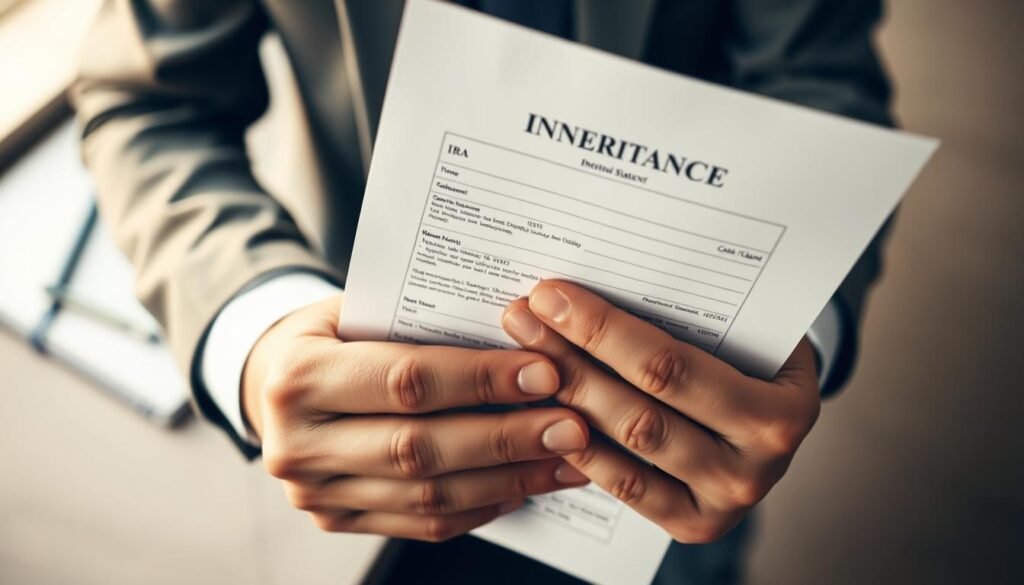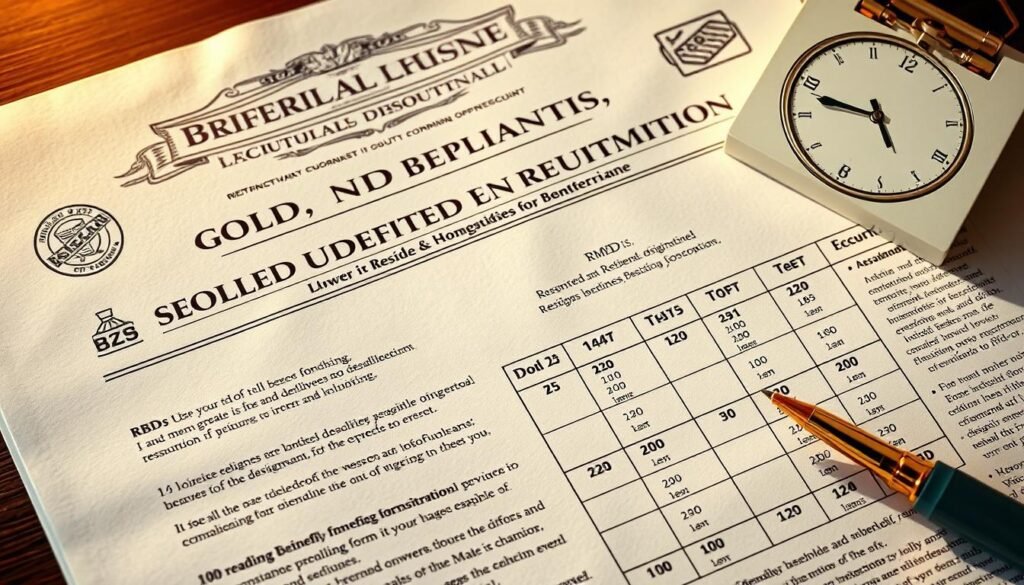Losing someone is never just paperwork. In the quiet that follows, you may find an unfamiliar stack of statements and a retirement account that needs decisions now.
This short guide explains how assets move from the account holder to a beneficiary under current rules. In plain terms: precious metals held in an IRA transfer into an inherited IRA structure and remain bound by the same distribution and reporting framework as other retirement accounts.
The SECURE Act changed timelines after 2019, so many non-spousal beneficiaries face a 10-year window for full distribution. Spouses often have more options and can delay required withdrawals by treating the funds as their own.
Custodians will verify beneficiary status, request a certified death certificate, and then coordinate transfers, in-kind moves of coins or bars, or liquidation. For a quick look at tax basics for this type of account, see this resource on taxation for precious metal IRAs: tax rules for gold IRAs.
Key Takeaways
- Inherited IRAs form when the original owner dies and assets pass to a beneficiary.
- You cannot add new contributions to an inherited IRA; distribution timing depends on relationship and year of death.
- Spouses can often roll assets into their own IRA; non-spousal beneficiaries usually use a 10-year rule.
- Custodians handle transfers, sales, or in-kind shipments once they receive paperwork and a certified death certificate.
- Traditional IRA distributions are typically taxed as ordinary income; Roth rules may allow tax-free withdrawals.
Understanding a Gold IRA at Death: How Inheritance Works Today
After an account holder dies, creditors aside, the IRA shifts into an inherited account set up for the named beneficiary. This keeps metals, cash, and other holdings inside the retirement framework so tax and reporting rules remain consistent.
What an inherited IRA means for physical metal and other assets:
- An inherited ira is opened in the beneficiary’s name but titled to show the decedent and beneficiary for clarity.
- Physical metal that a custodian held stays within the accounts structure, just like mutual funds or cash.
- Beneficiaries cannot make new contributions to inherited iras; that restriction is IRS policy to prevent ongoing funding.
How transfers typically occur:
- Custodian-to-custodian transfers or in-kind moves send approved coins/bars to a qualified depository.
- Alternatively, custodians can liquidate metals to cash before distribution if the beneficiary chooses.
- Even for a lump-sum, assets usually move into an inherited ira first so reporting, withholding, and distributions follow the secure act and other rules tied to the year of death.
User Intent: What happens to a gold IRA when I pass away?
Quick answer: The owner’s precious metals remain inside the retirement framework and the holding converts into an inherited IRA for the named beneficiary.
Key timelines under the SECURE Act:
- For deaths after 2019 most non-spousal beneficiaries must empty the inherited account by the end of the tenth year after the year of death.
- If the original account holder had reached the required beginning date, the beneficiary generally must take annual RMDs in years 1–9 and then fully distribute by year 10.
- Spouses can usually roll assets into their own IRA and follow their own age-based schedule, often delaying RMDs until age 73.
If a year-of-death RMD was due and not yet taken, the beneficiary must take that distribution by December 31 of that year.
Metals can move in-kind to another qualified account or be liquidated to cash per custodian procedures. Tax treatment depends on account type: traditional distributions are typically taxable; qualified Roth withdrawals can be tax-free.
“Contact the custodian quickly, open the proper inherited account, and keep documents organized.”
For more on handling precious metal transfers and beneficiary steps, see inheriting precious metals.
Beneficiary Designations: Setting the Stage for Smooth Transfers
Clear beneficiary designations make transfer after death faster and far less costly. Keep forms current so the custodian has plain instructions on file. That helps avoid probate and speeds distributions to heirs.
Primary vs. contingent and common pitfalls
Primary beneficiaries receive assets first. Contingent beneficiaries act as backups if the primary cannot inherit. Naming both keeps the account out of probate.
Common errors include outdated forms after marriage, divorce, adoption, or a beneficiary’s death. Those mistakes can push assets into the estate instead of to named people.
Keeping designations current
- Review forms yearly and after major life events.
- Specify percentages and consider per stirpes language for multiple beneficiaries.
- Name trusts or charities only after checking how that affects distribution rules.
- Use full legal names and current contact details to avoid verification delays.
“A quick annual review of beneficiary paperwork can save heirs time, taxes, and stress.”
Tip: Store copies with estate documents and tell beneficiaries which custodian holds the ira and retirement account. Clear designations help heirs meet year deadlines and choose the best distribution options.
The IRA Custodian’s Role After Death
The custodian acts quickly after being told of a death, guiding beneficiaries through required steps. Their job is to verify, protect holdings, and set up the proper inherited account so rules and reporting stay clear.
Documents your beneficiaries will need
Call the custodian first and ask which original documents they require. Typical paperwork includes a certified death certificate and government ID for the beneficiary.
Other items often requested: beneficiary proof such as social security number, the original account statements, and a signed transfer form to open the inherited ira account.

Transferring, liquidating, and storage logistics
Custodians offer two practical choices for precious metals. They can transfer coins or bars in-kind to an approved depository. Or they can liquidate metal and deposit the proceeds into the beneficiary’s account for distribution.
When metals move in-kind, the custodian coordinates insured shipment and storage with approved depositories and provides tracking and receipts.
Ensuring compliance with RMDs and reporting
The custodian calculates any required minimum distribution and confirms the amount and the due date for the year. They also handle tax withholding options and file the necessary forms.
“Keep copies of all confirmations and statements for the full year to support filing and any future audits.”
| Step | Typical Documents | Custodian Action | Forms Issued |
|---|---|---|---|
| Notification | Death certificate, beneficiary ID | Verify beneficiary and open inherited ira account | Confirmation statement |
| Transfer choice | Transfer/liquidation instruction | Coordinate in-kind move or sell metals | Shipment receipts / settlement record |
| Year-end compliance | Account statements | Calculate RMD, confirm date and amount | 1099-R for distributions; 5498 year-end |
Practical tips: Ask about timelines, storage fees, and liquidation charges. Confirm if a year-of-death RMD is outstanding and how to handle it before the December date. Keep all confirmations for taxes and possible audits.
Spousal Beneficiaries: Options and How to Choose
When an account moves to a spouse, several clear paths lead to different timing and tax results.
Transfer or treat as your own
Roll or treat-as-own lets a spouse delay RMDs until they reach age 73. That usually lowers taxable income now and lets funds grow tax-deferred.
When keeping an inherited account helps
Keeping the inherited IRA can be better if a younger spouse needs early access without penalties. It can also preserve the decedent’s distribution schedule in some cases.
Timing when the owner had already started RMDs
If the account holder had begun taking RMDs, a spouse can continue that schedule or recalculate using their life expectancy. Confirm whether a year-of-death RMD must be taken by December 31.
- Compare paths: roll into your IRA, treat as your own, or keep inherited status.
- Consider: your current age, income needs, and whether taking rmds now makes sense.
- Remember: you cannot contribute to an inherited IRA, so merging often lets you keep saving.
“Talk with the custodian about titling and confirm any year deadlines before choosing an option.”
| Choice | Primary benefit | When it helps |
|---|---|---|
| Roll into your IRA | Delay RMDs until age 73 | Spouse near retirement; wants to keep contributing |
| Treat as your own | Simpler tax schedule; full control | Older spouse prefers unified accounts |
| Keep inherited IRA | Access before 59½; preserve decedent schedule | Younger spouse needing withdrawals or special timing |
Non-Spousal Beneficiaries: Rules Under the SECURE Act
Non-spouse heirs face specific timelines and categories that determine how inherited retirement assets must be distributed. Start by identifying which beneficiary class you fit into. That determines the schedule and any interim requirements.
Designated vs. Eligible Designated Beneficiaries
Designated Beneficiary: most non-spousal heirs who must follow the 10-year rule after deaths post‑2019.
Eligible Designated Beneficiary (EDB): minor children of the decedent, disabled or chronically ill individuals, and those not more than 10 years younger than the owner. EDBs keep certain lifetime-stretch benefits.
The 10‑Year Payout and RMDs
Under the 10-year rule, the inherited IRA must be fully distributed by the end of the tenth year after the year of death. If the owner had started RMDs, annual RMDs are generally required in years 1–9, then the account is emptied by year 10.
- Minor children switch to the 10‑year rule once they reach majority.
- Two siblings can differ: one minor child may get stretch treatment while an adult sibling follows the 10‑year schedule.
Tip: Confirm any year‑of‑death RMD and pay it by December 31. These distribution rules apply to metals and other holdings inside the inherited IRA.

“Document the decedent’s age, whether RMDs had begun, and your beneficiary category to set accurate deadlines.”
For a practical primer on beneficiary procedures, see IRA beneficiary rules.
Traditional vs. Roth Inherited IRAs: Distribution and Tax Differences
How an inherited account is taxed affects both short-term cash and long-term planning. Below is a clear comparison of the two main types and practical choices for beneficiaries.
Tax and income basics for traditional accounts
Traditional inherited IRA distributions are usually taxed as ordinary income. The account grows tax-deferred until you withdraw each amount.
This means every distribution can raise your taxable income and affect brackets or credits in the year taken.
Roth rules and potential tax-free treatment
Roth inherited IRA payouts can be tax-free if they meet qualified distribution rules. Beneficiaries still must follow the SECURE Act timing, including the 10-year framework unless an EDB applies.
The five-year rule may also determine whether Roth funds are fully tax-free for the beneficiary.
“Plan withdrawals across years to reduce taxable spikes and protect benefits tied to income levels.”
| Feature | Traditional IRA | Roth IRA |
|---|---|---|
| Tax on distributions | Ordinary income tax on each withdrawal | Tax-free if qualified; otherwise taxable rules may apply |
| Growth while in account | Tax-deferred growth | Tax-free growth if held long enough |
| Timing rules | Same SECURE Act timelines apply | Same SECURE Act timelines apply |
| Reporting | 1099-R shows taxable amounts; 5498 for year-end | 1099-R still reports distributions; 5498 shows contributions timing |
Practical tip: Coordinate withdrawals over multiple years, consider in-kind moves for mixed portfolios, and review Form 1099-R for accuracy. Talk with a CPA to optimize tax outcomes and cash needs.
RMDs, RBD, and Critical Deadlines Beneficiaries Must Meet
The first year after the owner’s death matters most for compliance. Confirm whether any required minimum withdrawal was due that year and act before calendar deadlines.

Year‑of‑death RMD by December 31
If the account holder had an outstanding RMD for that year, the beneficiary must take it by the December 31 date. Missing this can trigger steep penalties.
Call the custodian immediately to verify amounts and request a distribution. Keep paperwork and confirmation numbers for IRS records.
Required beginning date and age 73
Under current rules, RMDs generally start at age 73 for most owners. If the owner reached the required beginning date before death, non-spousal beneficiaries usually must take annual RMDs during the 10‑year window.
Quick checklist and practical notes
- Confirm the decedent’s age and whether the year RMD was paid.
- Identify beneficiary category and set calendar reminders for each year.
- Calculate each account’s RMD separately if you inherit multiple accounts.
- Review withholding choices to avoid a surprise tax bill.
“Getting the first-year steps right sets the foundation for smooth compliance across the remaining years.”
Trusts, Estates, and Other Non-Individual Beneficiaries
When an account names a non-person as beneficiary, the payout clocks and rules shift in important ways.
Estates, charities, and many trusts do not get the same treatment as individual heirs under distribution rules. How the original owner stood relative to the required beginning date (RBD) determines which timeline applies.
Five-year vs. owner life-expectancy timelines
If the owner had not reached the RBD, the five-year rule generally forces full distribution by the end of the fifth year after the year of death.
If the owner had already reached the RBD, payouts often follow the original owner’s single life expectancy for required withdrawals.
Trusts as beneficiaries: control and complexity
A properly drafted see-through trust can allow custodians to treat distributions as if paid to individuals. That look-through status can preserve life-expectancy treatment instead of the five-year rule.
Key cautions: trust language, trustee documentation, and timely delivery to the custodian matter. Poor wording can accelerate payouts or trigger unintended tax timing.
“Coordinate with your estate attorney, CPA, and custodian so dates, calculations, and trust status line up.”
| Non-Individual Type | When Owner Reached RBD | When Owner Had Not Reached RBD |
|---|---|---|
| Estate | Based on owner life expectancy | Five-year rule; distribute by year five |
| Charity | Often immediate/accelerated distributions | Five-year rule; consult custodian for timing |
| Trust (see-through) | Can use owner-based life expectancy | May still face five-year rule if trust fails tests |
Step-by-Step: How to Inherit and Manage a Gold IRA
A quick, organized first contact with the custodian reduces delays and helps preserve the account’s value.
Initial steps: Call the custodian, provide a certified death certificate, and confirm your beneficiary status. Ask them to open the inherited ira in the correct title for the account so holdings move under proper rules.
Choose your distribution path: Decide whether to keep the inherited schedule, request an in-kind transfer to another qualified account, or take a lump-sum. Each option affects tax and upcoming income, so note the date and amount deadlines tied to your choice.
Practical checklist
- Verify beneficiary percentages and whether co-beneficiaries need separate inherited accounts.
- Ask if a year-of-death RMD is due and confirm the exact date for payment.
- Decide on metal liquidation versus in-kind transfer and review depository fees and storage terms.
- Set withholding for each distribution and confirm how Forms 1099-R and 5498 will be delivered.
- Keep all statements, shipment receipts, and date-stamped paperwork for the account owner’s file.
“Call the custodian first, document every step, and work with a CPA to spread distributions across years.”
Conclusion
A well-documented plan helps beneficiaries follow distribution timelines and tax rules.
In short: an inherited IRA follows the same retirement account framework as other plans, with extra steps for physical metals and storage. Clear beneficiary forms and prompt action in the year of death cut delays and reduce costs.
Spouses have distinct choices that can align distributions with their age and goals. Most non-spousal beneficiaries must empty the account within ten years, and some must take annual RMDs if the owner had begun withdrawals.
Work closely with the custodian on titling, transfers, and Forms 1099-R and 5498. Talk with a tax or legal advisor to optimize timing. With good records and timely steps, beneficiaries can manage distributions confidently and stay within the rules.
